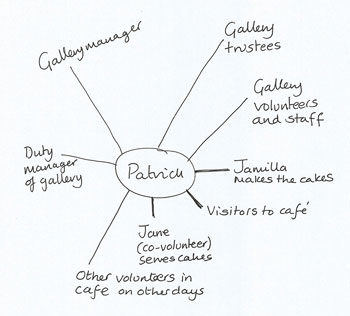2.4 Reviewing expectations
The discussion about influences on roles highlights the fact that conflict can arise from people’s expectations of you. Conflict is not always negative: it can open up discussions and lead to positive results such as acknowledging difficult issues that are then resolved, for example, a promotion, a pay rise, new training opportunities, new ways of working, and so on.
It is useful to consider what you represent to others, or what needs they have that they want you to respond to – expectations you may hardly be aware of. You do not need to be working as a manager to find that these issues crop up regularly.
In the next activity you will be thinking about how you work with others and whether there is any role conflict or role ambiguity.
Activity 3 Role expectations
Choose an example from work, volunteering or in the community where you interact with other people. Draw a ‘star chart’ to represent your role as follows:
- Quickly list the people you deal with and who are important to you in doing your work (paid or unpaid). Include people both within the organisation and outside it (for example, service users, funders, head office, local government, etc.). If there are more than, say, 10, try grouping similar ones together.
- Draw a circle to represent yourself in the middle, and put the names (or types) of people you deal with around the circle. Place them nearer or further from the centre, according to the amount of contact you have with them.
- Draw lines from the circle to the people, using thicker lines for more important relationships and thinner lines for less important ones. (A work relationship may, of course, be important without there being very much day-to-day contact.)
You can see an example in Figure 3 if you need some ideas to get you started.
Now briefly consider each relationship in turn and make a note of what you think is expected of you within the relationship. Finally, note any areas of actual or potential role conflict and ambiguity.
Comment
Hopefully, this activity gave you some insight into which relationships are most important for your work, and the different expectations others have of you. It may also have clarified why some aspects of your work are more comfortable than others: are you expected to be a different person in some circumstances?
If you work or volunteer for more than one organisation, you might like to compare star charts for these different roles.
Activity 3 will have given you a sense of roles in organisations and how people work with others. If you are currently working or volunteering, it might also have started you thinking about how your organisation functions, how it is managed and who makes decisions, as well as whether you work with people in other organisations.
Voluntary organisations often work in partnership with outside agencies, such as local government or major funders. Some of these relationships can be complex and involve contractual relationships. You will now look at voluntary organisations in more detail.

